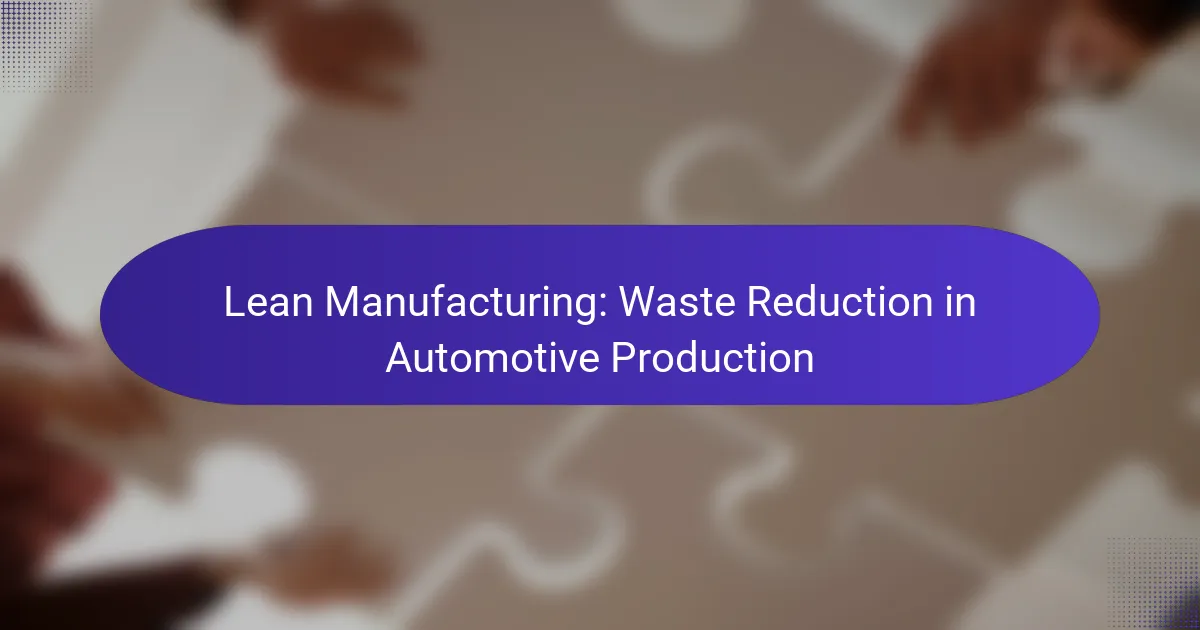Lean manufacturing plays a crucial role in waste reduction within the automotive industry by implementing strategies that enhance efficiency and streamline production processes. By utilizing techniques such as Just-in-Time manufacturing and Value Stream Mapping, automotive plants can systematically eliminate waste and optimize resource utilization, leading to faster production cycles and lower costs.

What are the best practices for waste reduction in automotive production?
Effective waste reduction in automotive production involves implementing strategies that streamline processes and minimize excess. Key practices include Just-in-Time manufacturing, Value Stream Mapping, 5S Methodology, Kaizen Continuous Improvement, and Lean Six Sigma Integration.
Just-in-Time (JIT) Manufacturing
Just-in-Time manufacturing focuses on producing only what is needed, when it is needed, and in the amount needed. This approach reduces inventory costs and minimizes waste associated with overproduction. For instance, automotive manufacturers can synchronize parts delivery with production schedules to ensure that components arrive just as they are required on the assembly line.
To implement JIT effectively, companies should establish strong relationships with suppliers and utilize real-time data to forecast demand accurately. However, it is crucial to maintain a buffer stock for critical components to avoid production delays due to unforeseen supply chain disruptions.
Value Stream Mapping
Value Stream Mapping is a visual tool that helps identify and analyze the flow of materials and information throughout the production process. By mapping out each step, manufacturers can pinpoint areas of waste, such as excess motion or waiting times, and develop strategies to eliminate them. This practice can lead to significant efficiency gains and cost reductions.
When creating a value stream map, include all relevant processes, from raw material acquisition to final product delivery. Regularly updating the map ensures that improvements are tracked and that the focus remains on continuous enhancement of the production flow.
5S Methodology
The 5S Methodology is a workplace organization technique that promotes efficiency and safety by maintaining a tidy and well-structured environment. The five steps—Sort, Set in order, Shine, Standardize, and Sustain—help eliminate clutter and streamline operations. For example, automotive assembly areas can benefit from clearly labeled tools and organized workspaces to reduce time spent searching for equipment.
To successfully implement 5S, involve all employees in the process and provide training on the importance of maintaining organization. Regular audits can help sustain the improvements and ensure adherence to the 5S principles over time.
Kaizen Continuous Improvement
Kaizen is a philosophy that emphasizes continuous improvement through small, incremental changes. In automotive production, this can involve regular team meetings to discuss potential enhancements and encourage employee input on process improvements. By fostering a culture of innovation, manufacturers can reduce waste and enhance productivity.
To apply Kaizen effectively, set measurable goals and encourage all employees to participate in identifying areas for improvement. Recognizing and rewarding contributions can further motivate teams to engage in the continuous improvement process.
Lean Six Sigma Integration
Lean Six Sigma combines the principles of Lean manufacturing and Six Sigma to enhance efficiency and quality. This integration focuses on reducing waste while improving process variability, leading to higher customer satisfaction and lower production costs. Automotive companies can apply Lean Six Sigma methodologies to streamline operations and eliminate defects.
Implementing Lean Six Sigma requires training employees in both Lean and Six Sigma techniques, as well as establishing a structured approach to problem-solving. Utilizing data-driven decision-making can help identify root causes of inefficiencies and guide targeted improvements in production processes.

How does Lean Manufacturing improve efficiency in automotive plants?
Lean manufacturing enhances efficiency in automotive plants by systematically eliminating waste, streamlining processes, and optimizing resource use. This approach focuses on continuous improvement, which leads to faster production cycles and reduced costs.
Reduction of Lead Times
Lean manufacturing significantly reduces lead times by minimizing non-value-added activities. Techniques such as value stream mapping help identify bottlenecks and streamline workflows, allowing for quicker turnaround from order to delivery.
For instance, implementing just-in-time (JIT) inventory practices can decrease lead times from weeks to days, ensuring that components arrive exactly when needed without excess stock. This agility is crucial in the competitive automotive market.
Minimized Inventory Costs
By adopting lean principles, automotive manufacturers can minimize inventory costs through better demand forecasting and inventory management. Reducing excess inventory not only lowers holding costs but also frees up capital for other investments.
For example, using Kanban systems allows teams to maintain optimal inventory levels, reducing waste and ensuring that resources are allocated efficiently. This can lead to savings of tens of thousands of dollars annually, depending on the scale of operations.
Enhanced Product Quality
Lean manufacturing improves product quality by fostering a culture of continuous improvement and encouraging employee involvement in quality control. Techniques such as root cause analysis help identify and eliminate defects at their source.
Additionally, implementing standardized work processes ensures consistency in production, which can lead to a reduction in defects by significant percentages. Regular training and feedback loops further enhance the quality of the final product, meeting or exceeding customer expectations.

What tools are used in Lean Manufacturing for waste reduction?
Lean manufacturing employs various tools to minimize waste and enhance efficiency in production processes. These tools focus on streamlining operations, improving quality, and reducing costs in automotive production.
Kanban Systems
Kanban systems are visual scheduling tools that help manage workflow and inventory levels. By using cards or signals to indicate when to produce or reorder items, Kanban minimizes excess inventory and reduces lead times.
In automotive production, Kanban can be implemented at various stages, such as assembly lines or parts supply. This approach allows teams to respond quickly to changes in demand, ensuring that resources are used efficiently without overproduction.
Root Cause Analysis Tools
Root cause analysis (RCA) tools are essential for identifying the underlying causes of defects and inefficiencies. Techniques like the “5 Whys” or fishbone diagrams help teams systematically explore problems and develop effective solutions.
In the context of automotive manufacturing, applying RCA can lead to significant improvements in quality and process reliability. By addressing root causes rather than symptoms, companies can prevent recurring issues and enhance overall productivity.
Software Solutions like SAP ERP
Software solutions, such as SAP ERP, integrate various business processes and provide real-time data analytics to support lean initiatives. These systems help track production metrics, manage supply chains, and optimize resource allocation.
Using SAP ERP in automotive production allows for better decision-making based on accurate data. It facilitates collaboration across departments, ensuring that waste reduction efforts are aligned with overall business goals. Companies can also customize dashboards to monitor key performance indicators relevant to their specific needs.

What are the key metrics for measuring waste reduction success?
Key metrics for measuring waste reduction success in automotive production include Overall Equipment Effectiveness (OEE), cycle time reduction, and scrap rate analysis. These metrics provide insights into efficiency, productivity, and material waste, helping manufacturers identify areas for improvement.
Overall Equipment Effectiveness (OEE)
Overall Equipment Effectiveness (OEE) is a comprehensive metric that evaluates the efficiency of manufacturing processes. It combines three factors: availability, performance, and quality, providing a clear picture of how well equipment is utilized. A typical OEE score ranges from 60% to 85%, with higher scores indicating better performance.
To improve OEE, manufacturers should focus on minimizing downtime, optimizing production speed, and ensuring high-quality output. Regular maintenance and employee training can significantly enhance these factors, leading to reduced waste and increased productivity.
Cycle Time Reduction
Cycle time reduction measures the time taken to complete one cycle of production, from start to finish. Shortening cycle times can lead to increased throughput and reduced lead times, which are crucial in the fast-paced automotive industry. A reduction of even a few seconds per cycle can result in substantial gains over high-volume production runs.
To achieve cycle time reduction, manufacturers can implement lean techniques such as value stream mapping and continuous flow production. Identifying bottlenecks and streamlining processes are essential steps in this effort, as they directly impact overall efficiency and waste reduction.
Scrap Rate Analysis
Scrap rate analysis involves tracking the percentage of materials that are wasted during production. A high scrap rate indicates inefficiencies and can lead to increased costs, making it a critical metric for waste reduction. Automotive manufacturers typically aim for a scrap rate of less than 5%, although this can vary based on specific processes and materials used.
To reduce scrap rates, companies should analyze production processes for defects and inefficiencies. Implementing quality control measures and using advanced manufacturing technologies can help minimize waste, ultimately leading to cost savings and improved sustainability.

What challenges do automotive manufacturers face in implementing Lean practices?
Automotive manufacturers encounter several challenges when adopting Lean practices, primarily due to ingrained habits, workforce readiness, and financial considerations. These obstacles can hinder the effective implementation of Lean methodologies aimed at waste reduction and efficiency improvement.
Resistance to Change
Resistance to change is a significant barrier in Lean implementation. Employees may be accustomed to traditional processes and hesitant to adopt new practices that disrupt their routine. To overcome this, management should communicate the benefits of Lean clearly and involve staff in the transition process.
Creating a culture that embraces change is crucial. Engaging team members in Lean initiatives can foster ownership and reduce resistance. Regular feedback sessions can help address concerns and reinforce the positive impact of Lean practices.
Training and Skill Gaps
Training and skill gaps present another challenge for automotive manufacturers. Employees may lack the necessary knowledge or skills to implement Lean techniques effectively. Investing in comprehensive training programs is essential to equip the workforce with the tools needed for success.
Consider utilizing a mix of on-the-job training, workshops, and mentorship programs to bridge these gaps. Continuous learning opportunities can help maintain a skilled workforce that is adaptable to Lean methodologies.
Initial Investment Costs
Initial investment costs can deter manufacturers from pursuing Lean practices. Implementing Lean often requires upfront expenditures for training, new technologies, and process redesign. However, these costs can lead to significant long-term savings through increased efficiency and reduced waste.
To manage these costs, companies should conduct a cost-benefit analysis to understand the potential return on investment. Exploring financing options or phased implementation can also help mitigate financial strain while transitioning to Lean practices.

How can automotive companies sustain Lean Manufacturing initiatives?
Automotive companies can sustain Lean Manufacturing initiatives by fostering a culture of continuous improvement and engaging employees at all levels. This involves implementing systematic approaches to eliminate waste, optimize processes, and enhance productivity.
Regular Training Programs
Regular training programs are essential for maintaining Lean Manufacturing practices in the automotive sector. These programs should focus on the principles of Lean, such as value stream mapping, 5S methodology, and Kaizen events, ensuring that employees understand and can apply these concepts effectively.
Training should be ongoing and tailored to different roles within the organization. For instance, operators may need hands-on training in specific tools and techniques, while managers might benefit from strategic training on Lean leadership and change management.
To maximize the effectiveness of training, companies should consider using a mix of formats, including workshops, e-learning, and on-the-job training. Regular assessments and feedback can help identify areas for improvement and ensure that the training remains relevant and impactful.



